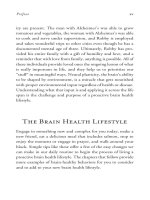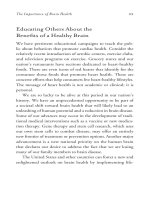The 5 Things You Must Do to Keep Your Mind Young and Sharp_13 ppt
Bạn đang xem bản rút gọn của tài liệu. Xem và tải ngay bản đầy đủ của tài liệu tại đây (236.63 KB, 15 trang )
Critical Area 5: Nutrition 179
Cranberry-Orange Bread
Makes 1 loaf (serves 12)
2 cups whole wheat fl our
½ cup sugar
¼ cup nonfat dry milk powder
1 teaspoon baking powder
1 teaspoon baking soda
1 teaspoon salt
¼ cup butter, melted
2 eggs
1 cup unsweetened orange juice
¼ cup walnuts, chopped
1½ cups fresh cranberries, coarsely chopped
Vegetable cooking spray
Preheat the oven to 350°F. Combine fl our, sugar, dry milk
powder, baking powder, baking soda, and salt in a large bowl.
Mix the butter, eggs, and orange juice in separate bowl. Add
to the fl our mixture, stirring just until moistened. Stir in the
walnuts and cranberries.
Coat a 9½Љϫ 5½Љϫ 2¾Љ loaf pan with the cooking spray,
then spoon the batter gently into the pan. Bake at 350°F for
1 hour or until a toothpick inserted into the center comes out
clean. Let cool in pan for at least 10 minutes, remove, and cool
before slicing.
One serving—Calories: 180; Total fat: 7 g; Total carbohydrates:
26 g; Protein: 4 g; Sodium: 400 mg
Save Your Brain180
Blueberry Nut Bread
Makes 1 loaf (serves 12)
1¼ cups unbleached fl our
¼ cup whole wheat fl our
½ teaspoon ground allspice
1 teaspoon baking powder
1 teaspoon baking soda
½ teaspoon salt
2 eggs
⅔ cup sugar
½ cup canola oil
1 teaspoon vanilla extract
½ cup canned crushed pineapple in natural juice,
undrained
¼ cup chopped toasted walnuts
1½ cups fresh blueberries
Preheat oven to 350°F. In a bowl, combine unbleached and
whole wheat fl ours, allspice, baking powder, baking soda, and
salt.
In a mixing bowl, beat eggs and the sugar until fl uffy, about
3 minutes. Beat in the oil and vanilla. Gently stir in the pine-
apple and its juice, nuts, and blueberries.
Pour into a 1½-quart loaf pan. Bake at 350°F in the oven
for 1 hour. Cool before slicing.
One slice (2½ ounces)—Calories: 210; Total fat: 12 g; Total
carbohydrates: 24 g; Protein: 3 g; Sodium: 260 mg
Critical Area 5: Nutrition 181
Blackberry Cobbler Rolls
Serves 10
1 cup plus 2 tablespoons sugar
1½ cups fl our
¼ teaspoon salt
2¼ teaspoons baking powder
1 cup butter or margarine, divided into two ½-cup
portions
⅓ cup milk, room temperature
2 cups fresh or frozen blackberries
½ teaspoon ground cinnamon
Preheat oven to 350°F. In a saucepan, heat 1 cup water and
1 cup of the sugar until the sugar melts; set aside. Put fl our,
salt, and baking powder into a mixing bowl; cut in half of the
butter or margarine until the consistency is fi ne crumbs. Add
milk and stir until dough leaves sides of bowl. Turn out onto
a fl oured surface; knead three or four times. Roll out to an 11Љ
ϫ 9Љ rectangle ¼ inch thick. Spread blackberries over dough
and sprinkle with cinnamon. Now roll up the dough length-
wise. Cut into 10 ¼-inch thick slices. In a 10-inch round or
oval baking dish, melt the remaining ½ cup of the butter. Lay
slices in baking dish over butter. Pour sugar syrup around slices;
syrup will be absorbed. Bake at 350°F for 45 minutes. Sprinkle
remaining sugar over the top and bake 15 minutes more. Serve
warm or cold.
One serving—Calories: 300; Total fat: 19 g; Total carbohy-
drates: 34 g; Protein: 3 g; Sodium: 320 mg
Save Your Brain182
Pineapple Upside-Down Cake
Serves 10
1 can (20 ounces) crushed pineapple with juice
3 tablespoons butter plus ⅓ cup butter
10 maraschino cherries
½ cup—or 10—walnut halves
⅔ packed cup brown sugar
½ cup white sugar
1 egg
1 teaspoon vanilla extract
1¼ cups sifted cake fl our
1½ teaspoons baking powder
½ teaspoon salt
½ cup reserved pineapple juice
Preheat oven to 350°F. Drain pineapple and reserve ½ cup of
the juice. Melt 3 tablespoons butter in a 9-inch round pan.
Arrange cherries and walnut halves in the buttery pan, and then
place the pineapple in the pan. Sprinkle with brown sugar.
In a mixing bowl, whisk together remaining butter and
granulated sugar until light and fl uffy. Add egg and vanilla,
and beat well. Sift fl our, baking powder, and salt. Add the fl our
mixture to the butter-sugar mixture alternately with reserved
pineapple syrup, beating after each addition.
Spread batter in pan over pineapple. Bake at 350°F for 45
to 50 minutes. Let stand 5 minutes in the pan, then fl ip over
onto plate. Serve warm.
One serving—Calories: 260; Total fat: 12 g; Total carbohy-
drates: 37 g; Protein: 3 g; Sodium: 140 mg
Critical Area 5: Nutrition 183
Blueberry Crisp
Serves 8
3 cups blueberries, fresh or frozen
¼ cup butter, softened
¾ cup plus ½ cup white sugar
1 cup fl our
⅛ teaspoon salt
1½ teaspoons baking powder
½ cup milk
1 tablespoon cornstarch
¼ teaspoon ground nutmeg
Preheat the oven to 350°F. Fill a small saucepan with water
and bring to boil while preparing recipe. Put the blueberries
into an 8-inch square baking dish. In a bowl, whisk together
the butter and ¾ cup white sugar until smooth. Stir the fl our
mixed with salt and baking powder into the butter mixture
alternately with the milk. Spoon batter over blueberries. Mix
together the remaining ½ cup sugar with the cornstarch and
nutmeg. Sprinkle over the top of the blueberries. Pour 1 cup of
the boiling water over the batter. Bake for 1 hour. Cool for at
least 10 minutes to set. Serve with whipped topping or vanilla
ice cream.
One serving—Calories: 230; Total fat: 6 g; Total carbohydrates:
47 g; Protein: 2 g; Sodium: 190 mg
Save Your Brain184
Yogurt Smoothie with Fruit
Serves 2
6 ounces low-fat yogurt
1 cup 2 percent milk
1 cup frozen or fresh raspberries or other fruit
1 medium banana sliced or 1 cup other fruit
Place all ingredients in blender or food processor. Cover and
blend on high for about 25 to 30 seconds or until smooth.
One serving—Calories: 190; Total fat: 3.5 g; Total carbohy-
drates: 35 g; Protein: 7 g; Sodium: 105 mg
Critical Area 5: Nutrition 185
Poached Peaches with Raspberry Sauce
Serves 8
8 large ripe peaches, all roughly the same size
¼ lemon, for juice
1 cup sugar
1 teaspoon vanilla
2 (10-ounce) packages of frozen raspberries
¾ cup jelly, preferably raspberry or cherry (or at
least red)
1½ teaspoons potato starch
2 tablespoons framboise or other liqueur
1 quart low-fat vanilla ice cream
Put the peaches in a large pot of boiling water and leave for
20 seconds. Remove the peaches and drop into a bowl of cold
water. Remove the peach skins and sprinkle lemon juice on the
peaches.
In another pan, pour sugar, vanilla, and 1¼ cup water. Bring
to a boil and place the peaches into pan to poach for about 6
to 8 minutes. Remove the peaches and cool them on a baking
sheet. Once cooled, cut the peaches in half and remove the pit.
Chill the peaches in the refrigerator.
Prepare the raspberry sauce by thawing the berries in a pan
along with the jelly and bringing the mixture to a boil. Mix in
1 tablespoon cold water and the potato starch. Stir until the
sauce is has cooked down. Add the framboise; stir for another
minute. Strain the sauce and let cool.
Save Your Brain186
When ready to serve, place peaches in eight dessert bowls.
Add a scoop of ice cream over each and cover with raspberry
sauce.
One serving—Calories: 360; Total fat: 2.5 g; Total carbohy-
drates: 82 g; Protein: 5 g; Sodium: 55 mg
187
10
Pioneering a
Bold Future for
Brain Health
By turning inward with great curiosity and passion, we will not only
pioneer new understandings of the human brain, we will discover that
all of our answers are tucked deep inside our brain’s folds and grooves.
7
N
ow that you know about the fi ve critical domains of
brain health, it’s time to take those practical suggestions
and tips and implement brain health in all areas of your life.
Remember that the fi ve major components of the lifestyle are
socialization, physical activity, mental stimulation, spirituality,
and nutrition. In these areas, there are defi nitely proactive steps
you can take, backed by a growing body of research, to promote
brain health.
The fascinating fact about brain health is that we already
know what kinds of environments are likely to promote brain
health; we simply need to reorient our surrounding. Research
Save Your Brain188
tells us that an environment that is enriched and provides novel
and complex stimuli increases our potential for brain health by
building brain reserve. This brain reserve is thought to help
delay the onset of neurodegenerative diseases such as Alzhei-
mer’s, which helps to underscore the importance of a proactive
and lifelong pursuit of brain health, as we all want to maintain
our memories and life stories.
I have proposed implementation of a brain health lifestyle by
fi rst establishing brain health as a priority and desired cultural
shift. Regardless of the setting or environment, such as school,
workplace, and home, among others, the fi rst step that must
occur is both conceptual and informational. For those inter-
ested in your own brain health, it is critical that you become
educated on the basics of your brain, how it operates, and how
a proactive lifestyle can promote the health of your brain. This
text articulates my brain health lifestyle as a tangible example
of a proactive approach to brain health. There needs to be a
belief that persons within the environment can engage in and
benefi t from activities and a general lifestyle that promote brain
health.
For every entity that is interested in creating a brain-healthy
culture, distinct individuals emerge who are quite eager to learn
and lead the movement to brain health. I refer to these per-
sons as “brain health ambassadors,” and they become the core
staff within the existing environment to foster and promote
the change. Working closely with the brain health ambassa-
dors, I can help to keep a strategic focus and direction for the
team as the culture takes small but persistent steps toward brain
health.
Pioneering a Bold Future for Brain Health 189
Unlocking the Potential of
the Human Brain
It is tempting to try and discuss the brain in technical terms and
to try and advance predictions of brain function that are highly
theoretical. I generally believe the mystery of the human brain
will be unlocked in basic and simplistic terms, with ideas that
have a home more in the wisdom taught us by past generations
than a university laboratory. We may be surprised to discover
that the human brain can be best understood and shaped using
simplistic approaches, and it is this simplistic beauty that makes
the human brain truly remarkable. I think there is both com-
plexity and parsimony in the human brain, which probably is
the essence of its brilliance.
We have learned some basic truths about the human brain
that can help us to dream about the brain of tomorrow. These
truths include the following:
• The human brain is the most complicated and sophisti-
cated system ever designed in the history of our universe.
• We do not understand much about the human brain, and
we consistently underestimate its sheer capacity and power.
• The human brain has plasticity and can be shaped by envi-
ronment across the life span.
• The human brain can develop new brain cells in the hip-
pocampus and olfactory system. Interestingly, these two
regions of the brain are close to one another, and we can
all appreciate how memories that form in the hippocam-
Save Your Brain190
pus can have a trigger from a sense of smell. The same
process of environmental stimulation that can lead to new
brain-cell development in the hippocampus likely affects
the olfactory neural networks.
• The brain can be stimulated for health at any age.
• The human brain responds favorably to enriched environ-
ments where the stimuli are novel and complex.
• A proactive and lifelong brain health lifestyle builds brain
reserve important to delaying the onset of Alzheimer’s and
other dementias.
This understanding of the human brain is relatively new
and is signifi cantly different from our traditional understanding
of our brain as a rigid, fi xed, and essentially degrading system
from birth. We used to be entrenched in the idea of a “critical
period of brain development” that was fi xed, and thus ended,
in childhood. Plasticity was not considered an established fact
for humans even though rodent brains evinced plasticity more
than fi fty years ago. It is true that much has been learned about
the human brain in the past forty to fi fty years, and the next
fi fty years will provide us with an even greater understanding
of this critical part of our being.
Consider how the human species has evolved from a primi-
tive being unable to communicate to an upright and mobile
animal capable of many languages. We have moved from
hunter-gatherer to astronaut. We used to rely on a telephone
with one line, and now we have the ability to send e-mail or text
messages across the planet in seconds. Air travel, space explora-
tion, and discoveries under our oceans have provided us the
ability to live more effi ciently and more productively. Most
Pioneering a Bold Future for Brain Health 191
signifi cant is our ability to generate, acquire, and process more
information today than at any other time in our history. All
one has to do is look up an idea to realize how much informa-
tion exists today. With all these advances, the rapid explosion
of information, and the ongoing upgrades to technology, we
must pause and refl ect upon how such creation occurs. It is
the human brain that permits such advancement, and it is the
brain that responds to such advancements. It is a systematic
dance that originates in the brain and returns to the brain in
the form of a new technology or piece of information. It is
from this interplay that the human brain grows, becomes more
sophisticated, and enriches the human race.
What does all this mean for the future of our species, for
the structure and function of our brain, and for improving the
human condition? As a curious animal, the human being will
continue to ask questions and to seek answers. We will improve
our species by becoming more technologically advanced, more
informed, and more capable of addressing those things that
threaten our existence. Our brains will continue to grow, prob-
ably with increased cortical mass and an even larger frontal lobe.
We will continue to develop new windows into the structure
and function of the human brain that will provide us with a
better understanding of how the brain works.
A New and Exciting World of
Neural Energies
The future of the human brain is fascinating to consider. I
believe the next decade will provide us insights into the power
Save Your Brain192
of the human brain that will yield a new frontier for new forms
of communication, control of energy outside the body, and a
new form of understanding as to how to manage and perhaps
reverse illness inside the body. This appreciation of the brain
as a brilliant and dynamic system of energy and the strategic
exploration to tap and utilize this energy are what I call “neural
energies.” Our ability to utilize this power of our brain will
advance our species in unprecedented ways.
The United States military is already conducting research on
how soldiers on the front line can communicate with other sol-
diers mentally, without opening the mouth. Case studies have
described persons paralyzed with no ability to speak or move
who maintain communication skills in the form of electrical
energy. That is, these individuals have been taught to use their
thoughts to create electrical energy that is transmitted across
electrodes placed on the skull and into a computer in which
a cursor moves over particular letters to form a sentence. I
recently read a report on the relationship between deep medita-
tion and slowing of HIV. Plenty of studies exist on the relation-
ship between prayer and positive outcomes in surgery, positive
attitude and successful outcomes with a particular illness, and
even a relationship between humor and positive health. We do
not understand how placebo works, but we do know that most
studies will yield a 25 percent positive outcome for patients
placed in a placebo group. Placebo might actually be a misun-
derstood form of treatment.
Such fi ndings exist today, and though we cannot explain
them very well, they seem to underscore the power of the mind
to manage or manipulate the body. Sports psychology is a
Pioneering a Bold Future for Brain Health 193
growing fi eld of expertise, as the world’s best athletes recognize
the value in visualization, relaxation, focus, and mentally cre-
ating success for physical performance. Indeed, an argument
can be made that the difference between the greatest athletes
and other professional athletes is their mental discipline and
ability to focus at the highest level. Their brains do not get dis-
tracted, and anxiety does not alter their physical performance.
Otherwise, there is very little difference between professional
athletes when comparing physical attributes or performance
mechanics.
The future pioneers of the human brain will explore neural
energies and how the electrical forces from such energies can
control matter within and outside the body. This has enormous
potential value for health care, as it can unleash completely
noninvasive methods to treat disorders throughout the body.
It also has enormous value for communication and will poten-
tially enable immediate interaction between any two or more
people on the planet. Neural energies could transform the body
within and enable interpersonal interaction in almost real time.
Neural energies may shape our species for many years.
Turning Inward for Answers
Perhaps as new methodologies emerge to explore and unleash
the powers of the human brain, we will discover new talents
and remedies to our most pressing needs. We may learn how
our neural energy can routinely regulate our bodies to homeo-
stasis with balanced levels of sugar and blood pressure. Cures









